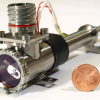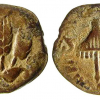Mass Spectrometry News
Agilent Technologies and the Bioprocessing Technology Institute (BTI), a research institute of Singapore’s Agency for Science, Technology and Research (A*STAR), have announced that they will collaborate on new analytical approaches to analysing specific protein-linked sugar compounds.
Agilent Thought Leader Award supports search for biomarkers to better predict side effects of new medicines.
Archaeologists examining late period Mayan containers have identified nicotine traces from a codex-style flask, revealing the first physical evidence of tobacco use by ancient Mayans. The study published in Rapid Communications in Mass Spectrometry (doi: 10.1002/rcm.5339) reveals the flask is marked with Mayan hieroglyphics reading, “y-otoot ’u-may” (“the home of its/his/her tobacco”), making it only the second case to confirm that the text on the exterior of a Mayan vessel corresponds to its ancient use.
Super-eruptions are not the only type of eruption to be considered when evaluating hazards at volcanoes with protracted eruption histories, such as the Yellowstone (Wyoming), Long Valley (California), and Valles (New Mexico) calderas in the USA. There have been more than 23 effusive eruptions of rhyolite lava at Yellowstone since the last caldera-forming eruption ~640,000 years ago, all of similar or greater magnitude than the largest volcanic eruptions of the 20th century.
Researchers have used mass spectrometry imaging to uncover exactly how a human egg captures an incoming sperm to begin the fertilisation process.
Europe is getting ready for its first unmanned visit to the surface of Mars. The first European Mars Rover on a joint mission of the American and European space agencies, NASA and ESA, will take off in 2018. The 250 kg Rover will roll over the surface of Mars at a speed of 100 m per hour. While doing so, it will inspect the surface and gather up ground and rock samples, some of them up to 2 m deep. The main goals of the so-called EXOMARS mission are to search for traces of former or present life on the earth-like planet, and to prepare for the arrival of a manned Mars landing.
Elemental and isotope analysis of the metals in ancient artefacts such as the prutah shown here sometimes can pinpoint the places where the metal was mined. This can be combined with historical sources to determine when the coin was likely struck. Archaeologists can use the evidence to identify or narrow date ranges of historical significance.
Agilent Technologies and Stemina Biomarker Discovery have announced efforts to accelerate Stemina’s metobolomic research
Researchers from Ohio State University, USA, have developed a rapid, multiplexed genotyping method to identify the single nucleotide polymorphisms (SNPs) that affect warfarin dose.
A famous Neolithic Iceman dressed in clothes made from sheep and cattle hair, a new study shows. The researchers say their findings support the idea that the Iceman was a herdsman, and that their technique, reported today in the journal Rapid Communications in Mass Spectrometry (doi: 10.1002/rcm.3679), has use in the modern clothing industry.



